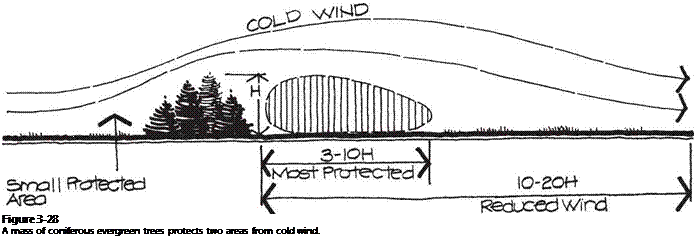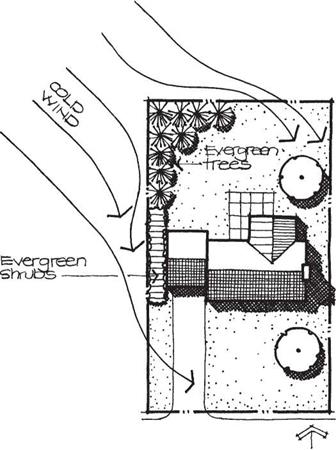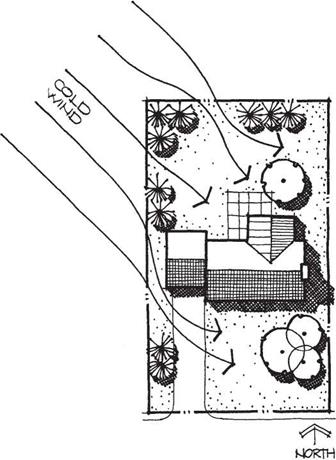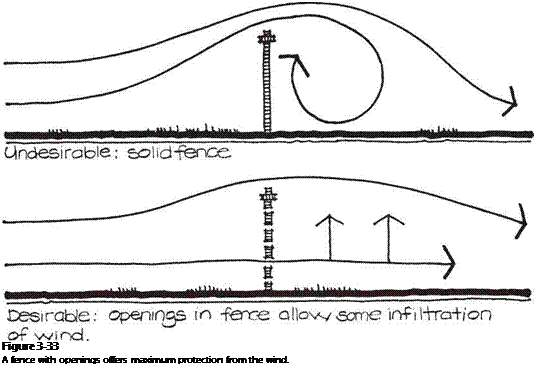There are numerous means for protecting both outdoor spaces and the house from the potentially detrimental effects of wind blowing from the westerly direction. These include proper location of outdoor use areas, use of vegetation, and employment of walls/fences as windscreens. Based on the microclimates around a house, it is best to place outdoor use areas requiring wind protection on the east and/or southeast side of
 |
Wind channeled 4o/vard Wind channeled awau
house – from house ^

the house, where the house itself blocks direct exposure to the cold west and northwest wind. This location is most desirable for outdoor use areas in late autumn, winter, and/or early spring.
In addition, vegetation can be used to screen and direct wind on the residential site. The foliage mass of plants acts like a solid object in the landscape to direct the wind around and over itself, thereby creating a protected, calm zone on the “lee” or opposite side from the wind. Coniferous evergreen trees and shrubs do this best because they possess relatively dense foliage throughout the year. Closely spaced coniferous evergreen trees function like a wall to direct wind up and over their mass, creating two protected zones (Figure 3—28). The smallest zone exists on the windward side of the tree mass, whereas the largest zone is on the lee side of the tree mass.
How much wind protection is created and for what distance beyond the tree mass depends on the height and density of the trees in the barrier. A general rule of thumb is that the open field velocity of wind can be reduced by up to 50 percent in the leeward zone for a distance that is approximately 10 to 20 times the height of the tree mass.[8] Within this zone, the maximum wind reduction occurs within a distance that is 3 to 10 times the height of the trees and becomes less pronounced as one moves further away. Thus, a 20′ high group of trees could be expected to notably reduce wind within a distance that is 60′ to 200′ from the tree mass.[9]
It should also be noted that the most efficient screening of wind from a group of trees occurs when the foliage density is approximately 50 to 60 percent.[10] That is, about 50 to 60 percent of the vegetation is foliage and trunk/branch structure while the remaining 40 to 50 percent is void or open space. This condition allows some wind to penetrate the tree mass and to uphold wind that is being pushed up and over the tree mass. When the density increases, the lack of wind through the mass permits the deflected wind to return to the ground more quickly, thus reducing the extent of the protected area. Thus, a moderately dense tree mass is actually more effective than a dense one.
To take advantage of their potential screening effect, coniferous trees and shrubs should be located on the west and northwest sides of the house as well as in outdoor spaces, where they can reduce the impact of cooling wind (Figure 3—29). To be effective, coniferous trees should be organized in a continuous band along the west and northwest edges of a site. Evergreen trees will not be effective if scattered in smaller
Figure 3-29

![]() Coniferous evergreen trees and shrubs should be massed on the west and northwest sides of the site for cold wind protection.
Coniferous evergreen trees and shrubs should be massed on the west and northwest sides of the site for cold wind protection.
groups, because this will create openings allowing wind to flow through (Figure 3—30). In fact, gaps in the tree mass may actually increase the wind’s velocity through these areas. Proper planting of coniferous evergreen vegetation can save up to 30 percent of the heating cost for the cool season of the year.[11]
Specific site conditions such as available space, orientation of the house to the street, and direction of desirable views may not always permit coniferous evergreen vegetation to be organized around the outer northwest quadrant of a site. Thus, one alternative approach is to mass coniferous evergreen shrubs immediately along the exterior wall of the house on the west and northwest sides (Figure 3—31). This coniferous shrub planting not only screens cold wind from the house wall, but also forms a “dead air space” between the plant mass and the house wall, in effect creating an additional layer of insulation. This technique also reduces heating costs.
A disadvantage of using coniferous vegetation to block wind is that it covers a relatively large area of ground. An alternative that requires less space is to use walls and fences to screen unwanted cold wind. These too can be used to lift the wind above an outdoor space or away from the west and northwest walls of the house. One potential application of this concept is to locate a wall or fence around the west and north sides of a front door entrance space on the north side of a house (Figure 3—32). Such a space is often inhospitably dark, cool, and windy because of its orientation. A carefully designed and located vertical plane can ameliorate the negative aspects of the space by blocking wind and permitting the front door to be opened and closed with diminished wind infiltration.
|
|
|


Oootd air ^jpooe. cots like о і оцет of msulofioo.
Figure 3-32

 |
Coniferous evergreen plants and a wall/fence can protect a doorway on the north side of the house.
As with vegetation, walls and fences are more effective windscreens when some wind is allowed to filter through them. A solid wall or fence acts like a dense vegetation mass by pulling the lifted wind back to the ground with eddies on the lee side (top of Figure 3—33). Therefore, walls or fences intended as windscreens should be designed with small openings or individual slats (louvers) that allow some wind to filter through (bottom of Figure 3—33). Some infiltration of wind helps to uplift the current that is
moving over the top of the fence. Vertical slats are often the best because they provide an even filtration of wind through the entire plane of the wall or fence. Horizontal slats that are angled upward will lift the wind somewhat above the space. Horizontal slats that are angled downward are not suggested because they direct the wind toward the ground, where it may disturb plants or move debris and dust about the space.
Several other approaches may also be taken to minimize exposure to cold wind. One is to use vertical panels of canvas that are suspended between posts or poles. This provides an opportunity for using bright color in a space while fulfilling the more utilitarian need to block wind. Tempered glass or Plexiglas panels may be desirable in locations where a view must be preserved while blocking wind. An outdoor space with a spectacular panoramic view that is intended for cool-season use is one example of a place where a glass wall would work well. The best method for screening wind is not necessarily achieved by either vegetation or walls/fences alone. Rather, it is frequently advantageous to combine these elements so they can form a coordinated approach to minimizing the potential negative effects of wind.



